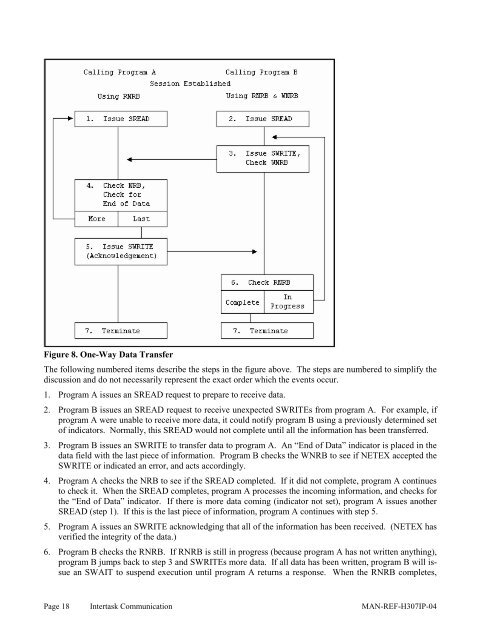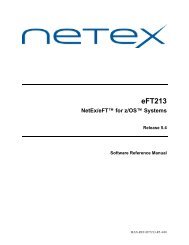SDISC Assembler Call - NetEx
SDISC Assembler Call - NetEx
SDISC Assembler Call - NetEx
- No tags were found...
Create successful ePaper yourself
Turn your PDF publications into a flip-book with our unique Google optimized e-Paper software.
Figure 8. One-Way Data TransferThe following numbered items describe the steps in the figure above. The steps are numbered to simplify thediscussion and do not necessarily represent the exact order which the events occur.1. Program A issues an SREAD request to prepare to receive data.2. Program B issues an SREAD request to receive unexpected SWRITEs from program A. For example, ifprogram A were unable to receive more data, it could notify program B using a previously determined setof indicators. Normally, this SREAD would not complete until all the information has been transferred.3. Program B issues an SWRITE to transfer data to program A. An “End of Data” indicator is placed in thedata field with the last piece of information. Program B checks the WNRB to see if NETEX accepted theSWRITE or indicated an error, and acts accordingly.4. Program A checks the NRB to see if the SREAD completed. If it did not complete, program A continuesto check it. When the SREAD completes, program A processes the incoming information, and checks forthe “End of Data” indicator. If there is more data coming (indicator not set), program A issues anotherSREAD (step 1). If this is the last piece of information, program A continues with step 5.5. Program A issues an SWRITE acknowledging that all of the information has been received. (NETEX hasverified the integrity of the data.)6. Program B checks the RNRB. If RNRB is still in progress (because program A has not written anything),program B jumps back to step 3 and SWRITEs more data. If all data has been written, program B will issuean SWAIT to suspend execution until program A returns a response. When the RNRB completes,Page 18 Intertask Communication MAN-REF-H307IP-04















